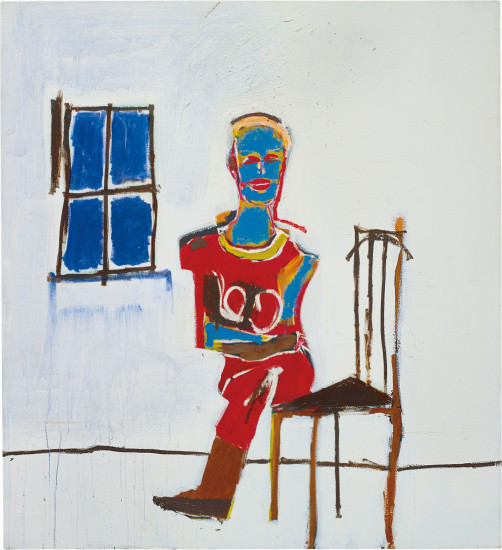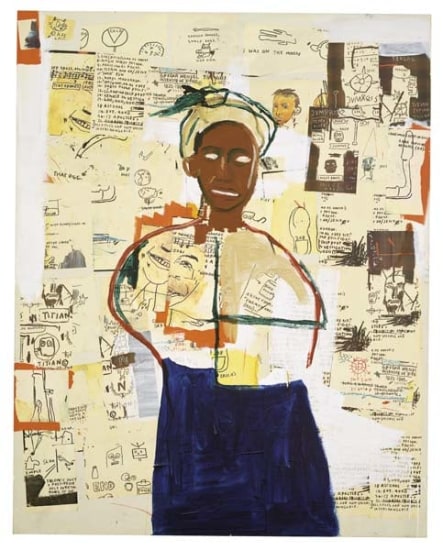Jean-Michel-Basquiat Untitled (Dinosaur) 1982 oil stick on paper 31.8 x 25 cm (12 1/2 x 9 7/8 in.) Signed 'Samo' lower right. This work is accompanied by a letter of authenticity issued by the Authentication Committee of the Estate of Jean-Michel-Basquiat.
Provenance Private Collection Woodward Gallery, New York Catalogue Essay 'I was a really lousy artist as a kid. Too abstract expressionist; or I'd draw a big ram's head, really messy. I'd never win painting contests. I remember losing to a guy who did a perfect Spiderman.' - JEAN-MICHEL-BASQUIAT, 1983 Jean-Michel-Basquiat’s fascination with graphic symbols suffuses his prolific career. Mixing imagery from a variety of subjects and sources including African jazz, Pop culture and Greco-Roman history, Basquiat was successful in forging his own visual lexicon that would come to define and encapsulate the explosion of cultural imagery that took place in 1980s New York. His work is ‘full of archaeological obsessions, dinosaur bones, baseball cards, pictures from old newspapers, traces of pop culture gone by.’ (J. Jones, ‘Forever young and miserable,’ The Guardian, March 10, 2000). Drawing upon Henry Dreyfuss’ 1972 Symbol Sourcebook for material, the artist found that the publication’s ‘organised, codified, and identified system of containing information was particularly suited to his artistic style of quick and emblematic art making.’ (R. D. Marshall quoted in Enrico Navarra, ed., Jean-Michel-Basquiat: Oeuvres sur Papier, Paris, 1999, p.42). The clean, basic symbols extracted from the sourcebook by Basquiat serve as the ingredients for many of his complex compositions. Given New York’s vibrant art scene in the 1980s, Basquiat was constantly surrounded by further inspiration; the Pop artists, Abstract expressionists and emerging street artists supplied him with limitless source imagery. Basquiat’s fascination with the symbolic fragments of history is reflected in both his works on paper and his paintings, amongst which he saw no artistic hierarchy, embracing both canvas and paper as equal surfaces for icon, form and text. For him, drawing ‘was something you did rather than something done, an activity rather than a medium.’ (Robert Storr in D. Buchhart, Basquiat, exh. cat., Fondation Beyler, Basel, 2010, p. 10). Known for his gestural approach to mark making and his dexterity with tools, whether it be paintbrush or oilstick, he has been acutely described as ‘a sophisticated and thoughtful artist with great resources of concentration, possessed of an unusual pictorial intelligence and an uncanny sense of unfolding history and of how to avoid its traps.’ (M. Mayer, Basquiat, Merrell Publishers , Brooklyn Museum, New York, 2005, p. 46). The present lot, Untitled (Dinosaur), isolates a single figure: a seated dinosaur rendered in sea blue. Gently humorous in its expression, the form is one of swift and flawless execution. Swatches of yellow and tan form the background of the composition while dashes of white oilstick highlight the dinosaur’s jagged claws, the arch of his back and his elongated nose holding small, serrated teeth. The dinosaur, like many of Basquiat’s appropriated symbols, recurs within other compositions including his 1984 painting Untitled (Two Crabs). Though often depicted as a ferocious creature of prehistory, colossal and menacing, Basquiat’s portrayal of the dinosaur is from a softer and more childlike perspective. Basquiat’s captivating imagery is greater than the sum of its parts. He plumbs vast and cryptic depths, and in all their intricacy of composition we must not revert to a cataloguing of representational objects in his works. 'We are not meant to analyse the pictures too carefully. Quantifying the encyclopedic breadth of his research certainly results in an interesting inventory, but the sum cannot adequately explain his pictures, which requires an effort outside the purview of iconography. He painted a calculated incoherence, calibrating the mystery of what such apparently meaning-laden pictures might ultimately mean.’ (M. Mayer, Basquiat, Merrell Publishers, Brooklyn Museum, New York, 2005, p. 50). His ability to integrate the past, present and future into one picture plane is perhaps Basquiat's most notewo
Jean-Michel-Basquiat Untitled (Dinosaur) 1982 oil stick on paper 31.8 x 25 cm (12 1/2 x 9 7/8 in.) Signed 'Samo' lower right. This work is accompanied by a letter of authenticity issued by the Authentication Committee of the Estate of Jean-Michel-Basquiat.
Provenance Private Collection Woodward Gallery, New York Catalogue Essay 'I was a really lousy artist as a kid. Too abstract expressionist; or I'd draw a big ram's head, really messy. I'd never win painting contests. I remember losing to a guy who did a perfect Spiderman.' - JEAN-MICHEL-BASQUIAT, 1983 Jean-Michel-Basquiat’s fascination with graphic symbols suffuses his prolific career. Mixing imagery from a variety of subjects and sources including African jazz, Pop culture and Greco-Roman history, Basquiat was successful in forging his own visual lexicon that would come to define and encapsulate the explosion of cultural imagery that took place in 1980s New York. His work is ‘full of archaeological obsessions, dinosaur bones, baseball cards, pictures from old newspapers, traces of pop culture gone by.’ (J. Jones, ‘Forever young and miserable,’ The Guardian, March 10, 2000). Drawing upon Henry Dreyfuss’ 1972 Symbol Sourcebook for material, the artist found that the publication’s ‘organised, codified, and identified system of containing information was particularly suited to his artistic style of quick and emblematic art making.’ (R. D. Marshall quoted in Enrico Navarra, ed., Jean-Michel-Basquiat: Oeuvres sur Papier, Paris, 1999, p.42). The clean, basic symbols extracted from the sourcebook by Basquiat serve as the ingredients for many of his complex compositions. Given New York’s vibrant art scene in the 1980s, Basquiat was constantly surrounded by further inspiration; the Pop artists, Abstract expressionists and emerging street artists supplied him with limitless source imagery. Basquiat’s fascination with the symbolic fragments of history is reflected in both his works on paper and his paintings, amongst which he saw no artistic hierarchy, embracing both canvas and paper as equal surfaces for icon, form and text. For him, drawing ‘was something you did rather than something done, an activity rather than a medium.’ (Robert Storr in D. Buchhart, Basquiat, exh. cat., Fondation Beyler, Basel, 2010, p. 10). Known for his gestural approach to mark making and his dexterity with tools, whether it be paintbrush or oilstick, he has been acutely described as ‘a sophisticated and thoughtful artist with great resources of concentration, possessed of an unusual pictorial intelligence and an uncanny sense of unfolding history and of how to avoid its traps.’ (M. Mayer, Basquiat, Merrell Publishers , Brooklyn Museum, New York, 2005, p. 46). The present lot, Untitled (Dinosaur), isolates a single figure: a seated dinosaur rendered in sea blue. Gently humorous in its expression, the form is one of swift and flawless execution. Swatches of yellow and tan form the background of the composition while dashes of white oilstick highlight the dinosaur’s jagged claws, the arch of his back and his elongated nose holding small, serrated teeth. The dinosaur, like many of Basquiat’s appropriated symbols, recurs within other compositions including his 1984 painting Untitled (Two Crabs). Though often depicted as a ferocious creature of prehistory, colossal and menacing, Basquiat’s portrayal of the dinosaur is from a softer and more childlike perspective. Basquiat’s captivating imagery is greater than the sum of its parts. He plumbs vast and cryptic depths, and in all their intricacy of composition we must not revert to a cataloguing of representational objects in his works. 'We are not meant to analyse the pictures too carefully. Quantifying the encyclopedic breadth of his research certainly results in an interesting inventory, but the sum cannot adequately explain his pictures, which requires an effort outside the purview of iconography. He painted a calculated incoherence, calibrating the mystery of what such apparently meaning-laden pictures might ultimately mean.’ (M. Mayer, Basquiat, Merrell Publishers, Brooklyn Museum, New York, 2005, p. 50). His ability to integrate the past, present and future into one picture plane is perhaps Basquiat's most notewo

.jpg)









Testen Sie LotSearch und seine Premium-Features 7 Tage - ohne Kosten!
Lassen Sie sich automatisch über neue Objekte in kommenden Auktionen benachrichtigen.
Suchauftrag anlegen